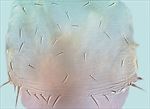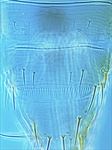Distinguishing features
Female macroptera. Body and legs mainly yellow; antennal segments II–VII brown; ocellar region sometimes slightly shaded, compound eyes with 4 ommatidia pigmented and slightly enlarged; mouth cone apex often dark; tergites II–VII with median light brown area, X brown at apex; fore wings pale. Antennae 7-segmented, segment I without paired dorso-apical setae; III–IV with sense cone forked. Head broad; ocellar setae I small, arising near inter-antennal projection, III arising between posterior ocelli; mouth cone massive, extending across prosternum. Pronotum with 4 pairs of posteromarginal setae, 2 pairs of posteroangular setae of which the external pair is much shorter than the inner pair. Metanotum with weak sculpture medially, median setae usually slightly posterior to anterior margin. Mesothoracic furca with weak spinula, metafurca usually with no spinula. Fore wing clavus with 5 marginal and 1 discal setae; first vein with 2 setae on distal third; second vein with 11-13 setae; posteromarginal cilia strongly wavy. Tergite I with transverse sculpture but no craspedum; tergites II–VII with sculpture medially progressively weaker on succeeding segments, posteromarginal craspedum entire; tergite II with 3 lateral marginal setae; tergite VIII posteromarginal comb complete, ctenidia present anterolateral to spiracles. Sternites III–VII with marginal craspedum shorter than diameter of a setal base.
Male macroptera. Similar to female but paler and smaller, mouth cone less elongate; antennal segment II as pale as segment I; tergite VIII with very reduced ctenidia, posteromarginal comb complete; sternites III–VII with transverse pore plate anterior to antecostal ridge.
Related species
The genus Lomatothrips includes two species, the other being associated with Podocarpus totara leaf buds in New Zealand. P. pinopsidis has the marginal comb on tergite VIII complete medially, not interrupted, and the mouth cone is exceptionally long and extends beyond the fore coxae. Body size is curiously variable, both between the sexes and between females from the same population. The largest female studied is almost twice as long as the smallest female, and the males are usually only half as long as females.
Biological data
Feeding and breeding in the male cones of Callitris rhomboidea, and Athrotaxis cupressoides [Cupressaceae], also Podocarpus lawrencei [Podocarpaceae].
Distribution data
Known only from Australia (Australian Capital Territory, New South Wales, Queensland near Brisbane, South Australia at Ngarkat Conservation Park)
Family name
THRIPIDAE - THRIPINAE
Species name
Lomatothrips pinopsidis Mound
Original name and synonyms
Lomatothrips pinopsidis Mound, 2006: 13.
References
Mound LA (2006) Vicariance or dispersal – trans-Tasman faunal relationships among Thysanoptera (Insecta), with a second species of Lomatothrips from Podocarpus. Papers and Proceedings of the Royal Society of Tasmania 140: 11–15.







